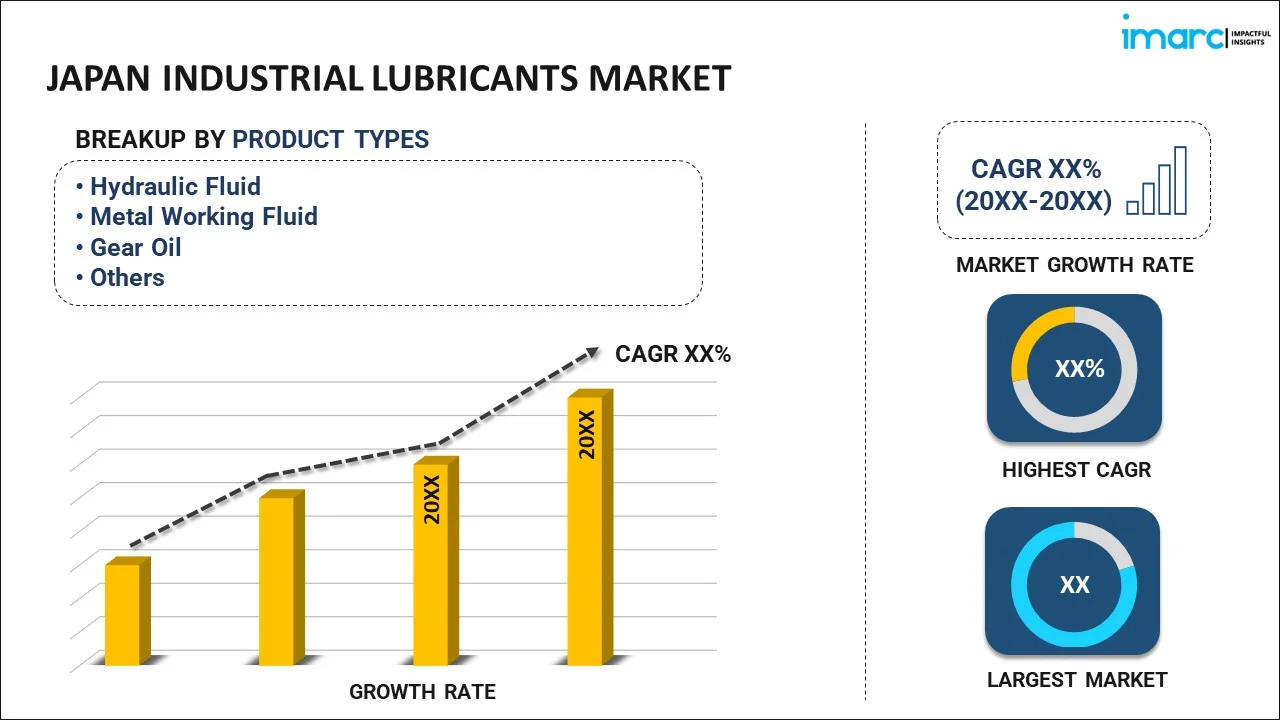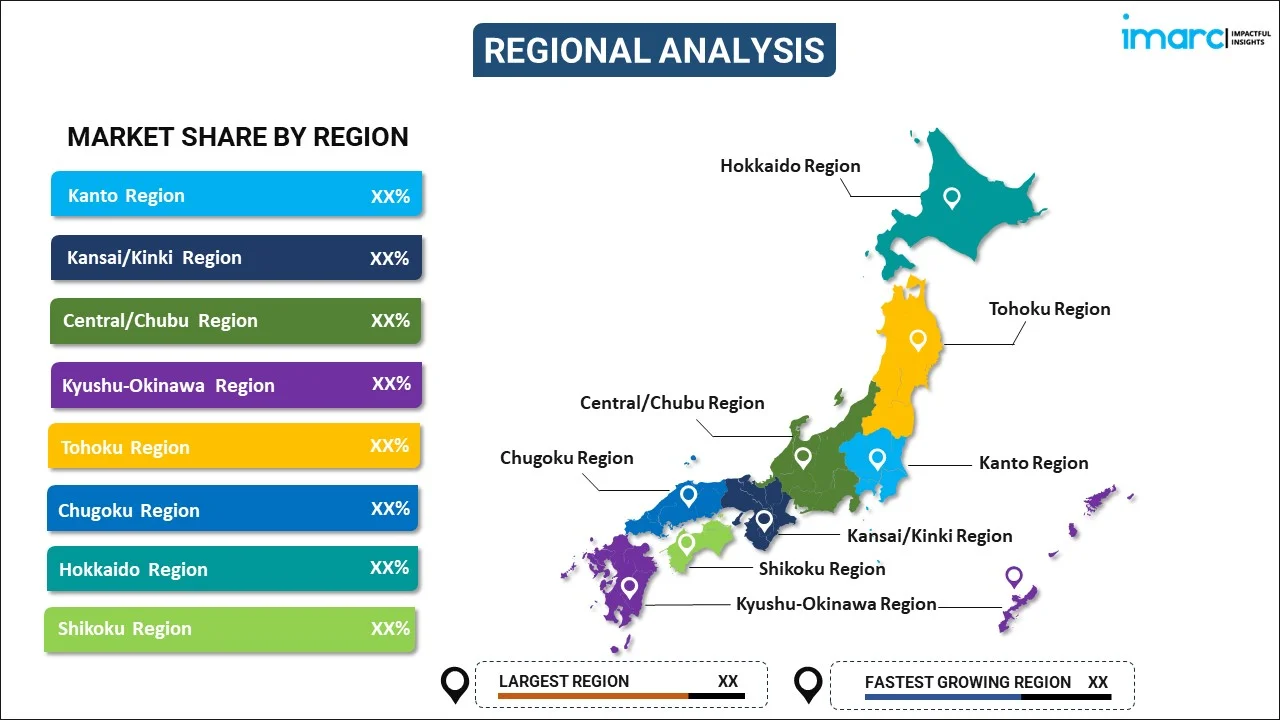
Japan Industrial Lubricants Market Report by Product Type (Hydraulic Fluid, Metal Working Fluid, Gear Oil, Grease, and Others), Base Oil (Mineral Oil, Synthetic Oil, Bio-based Oil), End Use Industry (Construction, Metal and Mining, Cement Production, Power Generation, Automotive, Chemical Production, Oil and Gas, Textile Manufacturing, Food Processing, Agriculture, Pulp and Paper, and Others), and Region 2025-2033
Market Overview:
Japan industrial lubricants market size reached USD 3.1 Billion in 2024. Looking forward, IMARC Group expects the market to reach USD 4.3 Billion by 2033, exhibiting a growth rate (CAGR) of 3.4% during 2025-2033. The increasing innovations in lubricant technology, such as the development of high-performance synthetic lubricants, bio-based lubricants, and specialty formulations, that can offer improved performance, extended equipment life, and environmental benefit, are driving the market.
|
Report Attribute
|
Key Statistics
|
|---|---|
|
Base Year
|
2024 |
|
Forecast Years
|
2025-2033
|
|
Historical Years
|
2019-2024
|
| Market Size in 2024 | USD 3.1 Billion |
| Market Forecast in 2033 | USD 4.3 Billion |
| Market Growth Rate (2025-2033) | 3.4% |
Industrial lubricants are specialized substances used in various industries to reduce friction and wear between moving parts in machinery and equipment. They play a critical role in maintaining the efficiency and longevity of industrial machinery by preventing metal-to-metal contact, reducing heat generation, and minimizing corrosion. These lubricants come in various forms, including oils, greases, and dry lubricants, tailored to specific applications and operating conditions. Industrial lubricants are formulated with base oils and additives to enhance their properties, such as viscosity, thermal stability, and anti-wear characteristics. They are used in a wide range of industries, including manufacturing, automotive, aerospace, mining, and energy production. These lubricants contribute to smoother operations, reduced downtime, and lower maintenance costs, ultimately improving the overall productivity and reliability of industrial processes. Proper selection and maintenance of industrial lubricants are essential to ensure the optimal performance of machinery, reduce energy consumption, and minimize environmental impact by controlling emissions and waste.
Japan Industrial Lubricants Market Trends:
The industrial lubricants market in Japan is poised for continued growth, driven by several key factors. Firstly, the increasing demand for machinery and equipment across various industries is a primary driver. As industrial sectors such as manufacturing, automotive, and aerospace expand, the need for efficient lubrication to reduce friction and wear becomes paramount. In addition to this, several stringent regulations and environmental concerns are propelling the market forward. Governments in Japan are imposing stricter emissions standards, leading manufacturers to develop eco-friendly lubricants that meet these requirements. This shift towards sustainability is pushing the adoption of bio-based and environmentally friendly lubricants. Furthermore, the emerging popularity of automation and Industry 4.0, which has led to more sophisticated machinery and equipment necessitating specialized lubricants to ensure optimal performance and longevity, is expected to drive the industrial lubricants market in Japan during the forecast period.
Japan Industrial Lubricants Market Segmentation:
IMARC Group provides an analysis of the key trends in each segment of the market, along with forecasts at the country level for 2025-2033. Our report has categorized the market based on product type, base oil, and end use industry.
Product Type Insights:

- Hydraulic Fluid
- Metal Working Fluid
- Gear Oil
- Grease
- Others
The report has provided a detailed breakup and analysis of the market based on the product type. This includes hydraulic fluid, metal working fluid, gear oil, grease, and others.
Base Oil Insights:
- Mineral Oil
- Synthetic Oil
- Bio-based Oil
A detailed breakup and analysis of the market based on the base oil have also been provided in the report. This includes mineral oil, synthetic oil, and bio-based oil.
End Use Industry Insights:
- Construction
- Metal and Mining
- Cement Production
- Power Generation
- Automotive
- Chemical Production
- Oil and Gas
- Textile Manufacturing
- Food Processing
- Agriculture
- Pulp and Paper
- Others
The report has provided a detailed breakup and analysis of the market based on the end use industry. This includes construction, metal and mining, cement production, power generation, automotive, chemical production, oil and gas, textile manufacturing, food processing, agriculture, pulp and paper, and others.
Regional Insights:

- Kanto Region
- Kansai/Kinki Region
- Central/ Chubu Region
- Kyushu-Okinawa Region
- Tohoku Region
- Chugoku Region
- Hokkaido Region
- Shikoku Region
The report has also provided a comprehensive analysis of all the major regional markets, which include Kanto Region, Kansai/Kinki Region, Central/ Chubu Region, Kyushu-Okinawa Region, Tohoku Region, Chugoku Region, Hokkaido Region, and Shikoku Region.
Competitive Landscape:
The market research report has also provided a comprehensive analysis of the competitive landscape. Competitive analysis such as market structure, key player positioning, top winning strategies, competitive dashboard, and company evaluation quadrant has been covered in the report. Also, detailed profiles of all major companies have been provided.
Japan Industrial Lubricants Market Report Coverage:
| Report Features | Details |
|---|---|
| Base Year of the Analysis | 2024 |
| Historical Period | 2019-2024 |
| Forecast Period | 2025-2033 |
| Units | Billion USD |
| Scope of the Report | Exploration of Historical Trends and Market Outlook, Industry Catalysts and Challenges, Segment-Wise Historical and Future Market Assessment:
|
| Product Types Covered | Hydraulic Fluid, Metal Working Fluid, Gear Oil, Grease, Others |
| Base Oils Covered | Mineral Oil, Synthetic Oil, Bio-based Oil |
| End Use Industries Covered | Construction, Metal and Mining, Cement Production, Power Generation, Automotive, Chemical Production, Oil and Gas, Textile Manufacturing, Food Processing, Agriculture, Pulp and Paper, Others |
| Regions Covered | Kanto Region, Kansai/Kinki Region, Central/ Chubu Region, Kyushu-Okinawa Region, Tohoku Region, Chugoku Region, Hokkaido Region, Shikoku Region |
| Customization Scope | 10% Free Customization |
| Post-Sale Analyst Support | 10-12 Weeks |
| Delivery Format | PDF and Excel through Email (We can also provide the editable version of the report in PPT/Word format on special request) |
Key Questions Answered in This Report:
- How has the Japan industrial lubricants market performed so far and how will it perform in the coming years?
- What has been the impact of COVID-19 on the Japan industrial lubricants market?
- What is the breakup of the Japan industrial lubricants market on the basis of product type?
- What is the breakup of the Japan industrial lubricants market on the basis of base oil?
- What is the breakup of the Japan industrial lubricants market on the basis of end use industry?
- What are the various stages in the value chain of the Japan industrial lubricants market?
- What are the key driving factors and challenges in the Japan industrial lubricants?
- What is the structure of the Japan industrial lubricants market and who are the key players?
- What is the degree of competition in the Japan industrial lubricants market?
Key Benefits for Stakeholders:
- IMARC’s industry report offers a comprehensive quantitative analysis of various market segments, historical and current market trends, market forecasts, and dynamics of the Japan industrial lubricants market from 2019-2033.
- The research report provides the latest information on the market drivers, challenges, and opportunities in the Japan industrial lubricants market.
- Porter's five forces analysis assist stakeholders in assessing the impact of new entrants, competitive rivalry, supplier power, buyer power, and the threat of substitution. It helps stakeholders to analyze the level of competition within the Japan industrial lubricants industry and its attractiveness.
- Competitive landscape allows stakeholders to understand their competitive environment and provides an insight into the current positions of key players in the market.
Need more help?
- Speak to our experienced analysts for insights on the current market scenarios.
- Include additional segments and countries to customize the report as per your requirement.
- Gain an unparalleled competitive advantage in your domain by understanding how to utilize the report and positively impacting your operations and revenue.
- For further assistance, please connect with our analysts.
 Inquire Before Buying
Inquire Before Buying
 Speak to an Analyst
Speak to an Analyst
 Request Brochure
Request Brochure
 Request Customization
Request Customization




.webp)




.webp)












